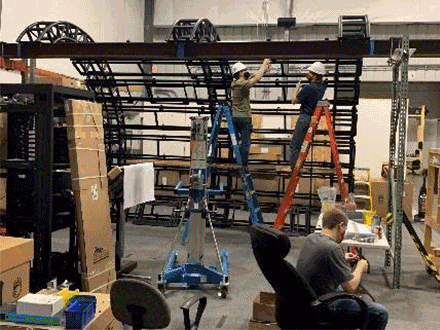Viz Lab: Virtual Reality Tours the Cosmos
Carnegie In The News
"The runaway star was spotted by an international team of astronomers led by Ting Li of the Carnegie Observatories."

At the heart of VizLab is an advanced visualization system shown in the artist’s concept. It allows users to display data of any kind in multidimensions. Viz Lab, under construction , is made possible by a major grant from the Ahmanson Foundation. Carnegie astronomers are wrestling with a data tsunami from both our observable universe and from the advanced numerical models that enable us to understand modern observations. The next generation of these calculations and surveys, such as the all-sky Sloan Digital Sky Survey-V led by Juna Kollmeier, Founding Director of the Carnegie Theoretical Astrophysics Center, requires new methods and tools for interrogating the universe and comparing it with our theoretical understanding. Enter VizLab, where real and simulated data can be analyzed with 21st-century, multidimensional representations using modern virtual reality tools.
Simulated and observed data are needed in tandem to test astronomical and cosmological predictions. Astronomy’s capacity to record increasing amounts of information from more numerous objects in the universe, combined with the ability to numerically simulate the evolution of the universe, is a natural consequence of advances in computing ability. Carnegie astronomers have pioneered advanced astronomical telescopes and instrumentation for over 100 years. The VizLab is a natural outgrowth of this tradition.
VizLab was constructed last fall in a former garage at the Observatories in Pasadena, California, and is becoming a space where scientists can probe their simulated and observed data to answer the most pressing scientific questions of the day, such as examining the energetic forces of black holes in galaxy centers, studying the highest energy particles in the universe, developing techniques to understand the mysteries of “dark matter” and “dark energy,” unraveling the mechanisms of supernovae explosions, refining the expansion rate of the universe, and much more.
In addition to these scientific pursuits, Viz Lab will help to educate the next generation of Carnegie scientists. The Observatories has a long history of engaging students and the public about the vast universe that surrounds them. Learners from the youngest to the oldest will be able to take virtual tours of Carnegie telescopes at its Las Campanas Observatory in Chile, walking through the control room, onto the observing floor, and even up the telescope sides, as examples. VizLab passed its site acceptance test at the end of September 2020, and will open safely to visitors in 2021.

At the heart of Viz Lab is an advanced visualization system shown in the artist’s concept, above. It allows users to display data of any kind in multidimensions. Image courtesy Juna Kollmeier, Carnegie Institution for Science

Viz Lab, under construction, is made possible by a major grant from the Ahmanson Foundation. Images courtesy Juna Kollmeier, Carnegie Institution for Science
Construction of Viz Lab is in progress, including building the advanced visualization system. The images above shows the supporting structure, with the screen being applied and the system developing into that displayed by the artist’s concept. Viz Lab is being constructed in a renovated garage on the Observatories property in Pasadena, California.

